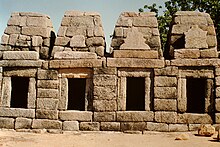Chausath Yogini Temple (Khajuraho)

The Chausath Yogini Temple ("64 Yogini Temple"), which is largely in ruins, is considered the oldest temple in Khajuraho . It belongs to a group of about ten known yogini temples in the north ( Madhya Pradesh , Uttar Pradesh ) and northeast ( Orissa ) of India , of which only four have largely been preserved.
location
The Chausath Yogini Temple is located in largely flat terrain around 500 meters (as the crow flies) southwest of the large temple district of Khajuraho .
Consecration
The temple is dedicated to a group of 64 yoginis , each of whom was assigned its own small shrine.
architecture

The area was filled in and stabilized on the outside with uncut granite stones. While most of the Yogini temples are arranged around a round courtyard, the temple of Khajuraho is built on a rectangular floor plan (approx. 31 × 19 meters) with 10 shrines each on the narrow sides and 22 shrines each on the long sides. Opposite the former - now destroyed - entrance is another, somewhat larger and higher shrine, which may have been dedicated to a deity from the Hindu pantheon. A cult image has not been preserved in any of the shrines.
The shrines that have been preserved consist of large granite stones and are extremely simple - they show completely decor-free entrance portals with peculiar gable slabs and 'primitive' approaches of Shikhara towers (see Naresar ), so that some researchers date them to around 700; others advocate later dating to the early days of the Chandella dynasty (approx. 875).
Sculptures
Photographs from 1955 still exist of three of Khajuraho's yogini cult images; however, the sculptures themselves have disappeared. Furthermore, it is unclear whether the cult images date from the same time as the temple itself or whether they were created later. The three photos show Durga as a buffalo killer ( mahisasurmardini ), then Mahesvari (female aspect of Shiva with a trident ( trishula ) and a Nandi bull as companion animal) and the three-headed Brahmi (female aspect of Brahma with a goose as vahana ). The last two figures also belong to the group of matrikas ; Durga ( mahisasurmardini ) can often be found in their immediate vicinity.
Others
The temple grounds, which are largely in ruins, are still visited in the afternoons by the older women of the village, who - without the support of a Brahmin - hold their communal private puja ceremony, during which an important kalasha jugs filled with water and / or milk are held Role-play.
See also
literature
- Vidiya Dehejia: Yogini Cult and Temples - A Tantric Tradition. National Museum, New Delhi 1986.
- Michael W. Meister, MA Dhaky (Ed.): Encyclopaedia of Indian Temple Architecture. North India - Period of Early Maturity. Princeton University Press, Princeton 1991, pp. 84ff, ISBN 0-19-561537-9 .
Web links
- Chausath-Yogini Temple in Hirapur - Photos and information (Engl.)
- Chausath Yogini Temple in Mitauli - short video
Coordinates: 24 ° 50 ′ 55 ″ N , 79 ° 55 ′ 5 ″ E